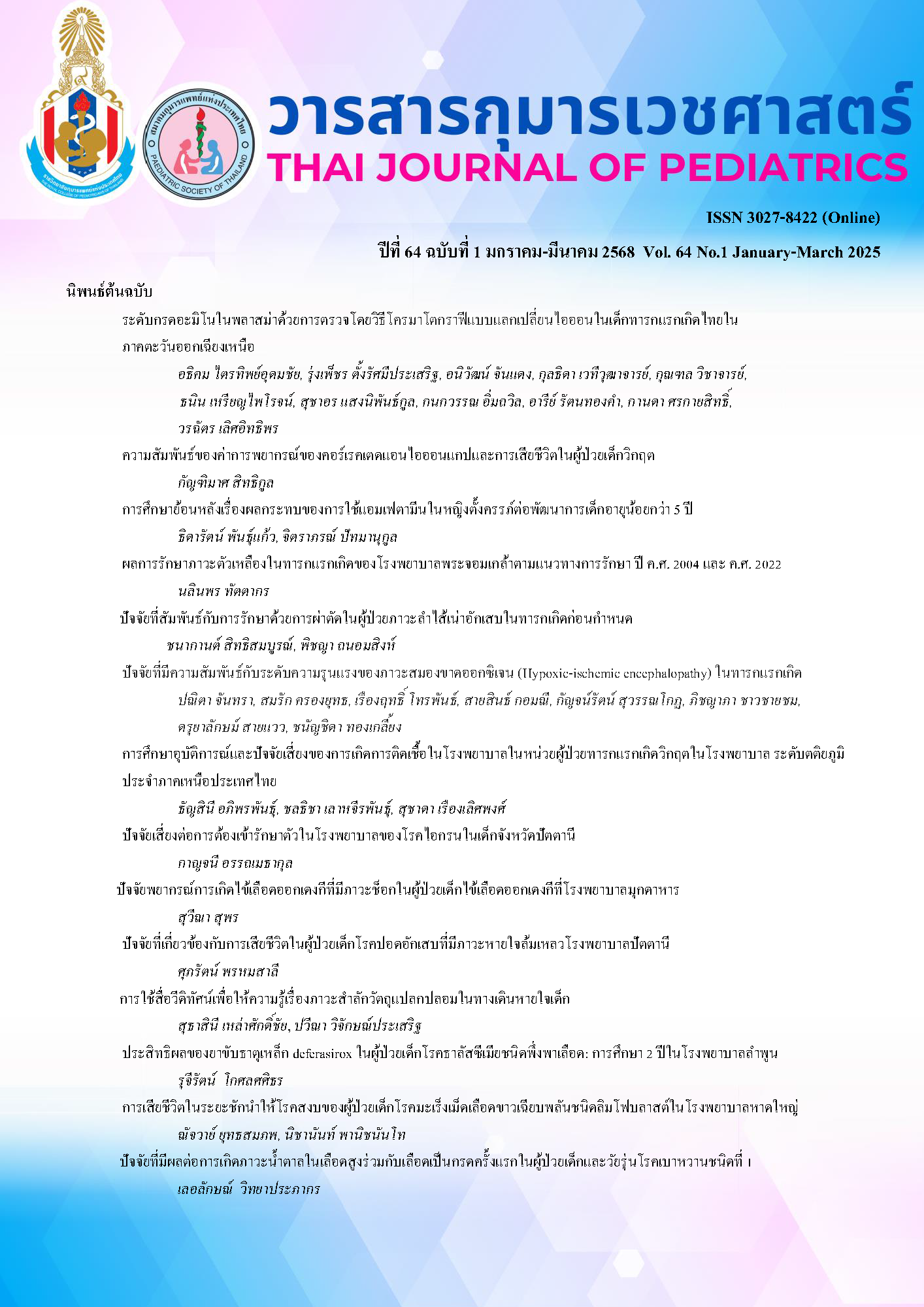ปัจจัยที่มีผลต่อการเกิดภาวะน้ำตาลในเลือดสูงร่วมกับเลือดเป็นกรดครั้งแรกในผู้ป่วยเด็กและวัยรุ่นโรคเบาหวานชนิดที่ 1
คำสำคัญ:
เบาหวานชนิดที่ 1, ตรวจการได้ยินระดับก้านสมอง, ปัจจัยเสี่ยง, ระดับน้ำตาลสะสมบทคัดย่อ
ความเป็นมา: ภาวะน้ำตาลในเลือดสูงร่วมกับเลือดเป็นกรด (DKA) เป็นภาวะแทรกซ้อนที่อาจเป็นอันตรายถึงแก่ชีวิต ในผู้ป่วยโรคเบาหวานชนิดที่ 1
วัตถุประสงค์: ศึกษาปัจจัยเสี่ยงที่มีความสัมพันธ์กับการเกิดภาวะน้ำตาลในเลือดสูงร่วมกับเลือดเป็นกรดครั้งแรกหลังจากวินิจฉัย ในผู้ป่วยเด็กและวัยรุ่นโรคเบาหวานชนิดที่ 1
วิธีการศึกษา: การศึกษาจากเหตุไปหาผลแบบย้อนหลังในผู้ป่วยเด็กและวัยรุ่นโรคเบาหวานชนิดที่ 1 อายุ 1-20 ปี ที่มารับการรักษาที่คลินิกเบาหวานระหว่างวันที่ 1 มกราคม 2557 และ 31 ตุลาคม 2567 เก็บข้อมูลจากเวชระเบียน วิเคราะห์ข้อมูลโดยใช้ Kaplan Meier curve และ log rank test เพื่อเปรียบเทียบระยะปลอดเหตุการณ์ DKA ส่วน multivariate cox proportional hazard model ใช้หาปัจจัยเสี่ยงที่สัมพันธ์กับการเกิดภาวะ DKA ครั้งแรก
ผลการศึกษา: ผู้ป่วยเด็กและวัยรุ่นโรคเบาหวานชนิดที่ 1 จำนวน 120 คน มี 59 คน (ร้อยละ 49.2) เกิดภาวะ DKA ปัจจัยเสี่ยงที่สัมพันธ์กับการเกิดภาวะ DKA ครั้งแรกหลังจากวินิจฉัยอย่างมีนัยสำคัญทางสถิติได้แก่ ดัชนีมวลกายตามอายุและเพศ (AHR 0.52, 95%CI: 0.35, 0.78) ระดับน้ำตาลสะสม (AHR 1.21, 95%CI: 1.04, 1.41) การบริหารอินซูลินแบบ basal bolus เปรียบเทียบกับ conventional/modified (AHR 0.33, 95%CI: 0.15, 0.70) และตรวจติดตามที่คลินิกสม่ำเสมอเปรียบเทียบกับไม่สม่ำเสมอ (AHR 0.42, 95%CI: 0.18, 0.96) โดยมีค่ามัธยฐานของระยะปลอดภาวะ DKA อยู่ที่ 39 เดือน (95%CI: 30.0, 44.5) -อัตราการปลอดภาวะ DKA 1 และ 3 ปี คือ ร้อยละ 84.1 และ 74.5 ตามลำดับ อัตราการปลอดภาวะ DKA ใน 3 ปี ระหว่างผู้ป่วยที่มี HbA1c ≤ 9% และ HbA1c > 9% คือ ร้อยละ 97.3 (95%CI: 92.2, 100) และร้อยละ 65.4 (95%CI: 55.8, 76.7) ตามลำดับ มีความแตกต่างอย่างมีนัยสำคัญทางสถิติ (p value <0.001)
สรุป: ดัชนีมวลกายตามอายุและเพศต่ำ ระดับน้ำตาลสะสมสูง การบริหารอินซูลินแบบ conventional/modified และการตรวจติดตามที่คลินิกไม่สม่ำเสมอเป็นปัจจัยเสี่ยงที่สัมพันธ์กับการเกิดภาวะ DKA ครั้งแรกหลังจากวินิจฉัย ผู้ป่วยควรได้รับการบริหารอินซูลินแบบ basal bolus มาตรวจระดับน้ำตาลสะสมและติดตามที่คลินิกสม่ำเสมอ เพื่อลดความเสี่ยงการเกิดภาวะ DKA โดยเฉพาะในผู้ป่วยที่มีดัชนีมวลกายตามอายุและเพศที่ต่ำลง และระดับน้ำตาลสะสมที่สูงขึ้น
Downloads
เอกสารอ้างอิง
Glaser N, Fritsch M, Priyambada L, Rewers A, Cherubini V, Estrada S, et al. ISPAD Clinical practice consensus guidelines 2022: Diabetic ketoacidosis and hyperglycemic hyperosmolar state. Pediatr Diabetes. 2022;23:835-56.
Morgan E, Black CR, Abid N, Cardwell CR, McCance DR, Patterson CC. Mortality in type 1 diabetes diagnosed in childhood in Northern Ireland during 1989-2012: A population-based cohort study. Pediatr Diabetes. 2018;19:166-70.
Rewers A, Chase P, Mackenzie T, Walravens P, Roback M, Rewers M, et al. Predictors of acute complications in children with type 1 diabetes. JAMA. 2002;287:2511-8.
Zucchini S, Scaramuzza AE, Bonfanti R, Buono P, Cardella F, Cauvin V, et al. A multicenter retrospective survey regarding diabetes ketoacidosis management in Italian children with type 1 diabetes. J Diabetes Res. 2016;2016:5719470.
Rittiphairoj T, Owais M, Ward ZJ, Reddy CL, Yeh JM, Atun R. Incidence and prevalence of type 1 diabetes and diabetic ketoacidosis in children and adolescents (0-19 years) in Thailand (2015-2020): A nationwide population-based study. Lancet. 2022;21:1-13.
Hammerson J, Tittel SR, Warncke K, Fritsch M, Placzek K, Pacaud D, et al. Previous diabetic ketoacidosis as a risk factor for recurrence in a large prospective contemporary pediatric cohort: Results from DPV initiative. Pediatr Diabetes. 2021;22:455-62.
Al-Hayek AA, Robert AA, Braham RB, Turki AS, Al-Sabaan FS. Frequency and associated risk factors of recurrent diabetic ketoacidosis among Saudi adolescents with type 1 diabetes mellitus. Saudi Med J. 2015;36:216-20.
Assefa B, Zeleke H, Murugan R, Wondwossen K. Incidence and predictors of diabetic ketoacidosis among children with diabetes in west and east Gojjam zone referral hospitals, northern Ethiopia, 2019. Italian Journal of Pediatrics. 2020;46:164.
Shrestha SS, Zhang P, Barker L, Imperatore G. Medical expenditures associated with diabetes acute complications in privately insured U.S. youth. Diabetes Care. 2010;33:2617-22.
Dejkhamron P, Santiprabhob J, Likitmaskul S, Deerochanawong C, Rawdaree P, Tharavanij T, et al. Young-onset diabetes patients in Thailand: Data from Thai type 1 diabetes and diabetes diagnosed age before 30 years registry, care and netwirk (TIDDAR CN). J Diabetes Investig. 2022;13:796-809.
Albishi LA, Altoonisi MM, Alblewi SM, Osman RH, Ahmed NA, Fararjeh M. Clinical demographic patterns of type 1 diabetes in Saudi children in Tabuk City, 2000-2010. JDM. 2017;7:41-54.
Sokotowska-Gadoux M, Jarosz-Chobot P, Polanska J, Kalemba A, Chobot A. Body mass index and partial remission in 119 children with type 1 diabetes- a 6-year observational study. Frontiers in Endocrinology. 2023;14:1257758.
Cengiz E, Xing D, Wong JC, Wolfsdorf JI, Haymond MW, Rewers A, et al. Severe hypoglycemia and diabetic jetoacidosis among youth with type 1 diabetes in the T1D exchange clinic registry. Pediatr Diabetes. 2013;14:447-54.
Chou WY, Li YR, Chan WK, Chen ST. Association of diabetic ketoacidosis, severe hypoglycemia and glycemic control among children and young adults with type 1 diabetes mellitus treated with premixed versus basal-bolus insulin therapy. Biomedical Journal. 2018;41:348-55.
Fortin K, Pries E, Kwon S. Missed medical appointments and disease control in children with type 1 diabetes. J Pediatr Health Care. 2016;30:381-9.
Virmani A, Brink SJ, Middlehurst A, Mohsin F, Giraudo F, Sarda A, et al. ISPAD Clinical practice consensus guidelines 2022: Management of the child, adolescent, and young adult with diabetes in limited resource settings. Pediatr Diabetes. 2022;23:1529-51.
Cengiz E, Cheng P, Ruedy KJ, Kollman C, Tamborlane W, Klingensmith G, et al. Clinical outcomes in youth beyond the first year of type 1 diabetes: Results of the pediatric diabetes consortium (PDC) type 1 diabetes new onset (NeOn) study. Pediatr Diabetes. 2017;18:566-73.
Couper JJ, Haller MJ, Ziegler A-G, Knip M, Ludvigsson J, Craig ME. Phases of type 1 diabetes in children and adolescents. Pediatric Diabetes. 2014;15:18-25.
Rahak K, Ibrahim MN, Mahar S, Devi P, Noor N, Khoso ZA. Precipitating factors and outcome of diabetic ketoacidosis among children and adolescents with type 1 diabetes mellitus. Journal of the College of Physicians and Surgeons Pakistan. 2023;33:900-5.
Yasmin F, Ahmed MAU, Morshed ASM, Begum T, Mohsin F, Baki MA. Precipitating factors, clinical features and outcome of diabetic ketoacidosis in children in a tertiary care hospital of Bangladesh. BIRDEM MED J. 2019;9:121-6.
Reinehr T, Dieris B, Galler A, Teufel M, Berger G, Stachow R, et al. Worse metabolic control and dynamics of weight status in adolescent girls point to eating disorders in the first years after manifestation of type 1 diabetes mellitus: Finding from the diabetes Patiented Verlaufsdokumentation registry J Pediatr. 2019;207:205-12.
Bhatt P, Dave M, Amponsah JK, Jain A, Yagnik P, Asare-Afriyie B, et al. Etiologies, trends, and predictors of 30-day pediatric readmission after hospitalizations for diabetic ketoacidosis in the United State. Pediatr Diabetes. 2020;21:969-78.
ดาวน์โหลด
เผยแพร่แล้ว
รูปแบบการอ้างอิง
ฉบับ
ประเภทบทความ
สัญญาอนุญาต
ลิขสิทธิ์ (c) 2025 ราชวิทยาลัยกุมารแพทย์แห่งประเทศไทย และ สมาคมกุมารแพทย์แห่งประเทศไทย

อนุญาตภายใต้เงื่อนไข Creative Commons Attribution-NonCommercial-NoDerivatives 4.0 International License.



